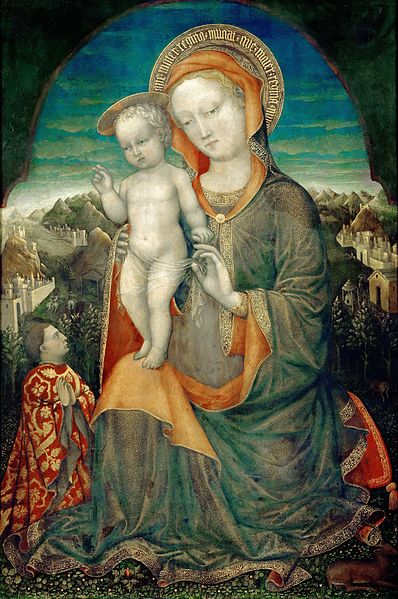Historiography has commonly referred to the kneeling figure at the feet of the Virgin as Leonello d’Este, although in recent years various interpretations have been given which suggest that the figure may be Ugo or Meliaduse, brothers of the Marquis. Although we cannot be sure of the identification of the person praying, we do know that it was an Este commissioned painting.
The Madonna of Humility owes this appellation to its iconography: she is depicted seated on the ground on a cushion and not on a throne. The Virgin holds the Child, here depicted standing in the act of blessing the commissioner. The latter is represented smaller in size to respect the hierarchy, has his hands joined in the act of prayer and wears a refined and precious cape with plant and floral motifs in gold and purple. The hair is similar to that worn by Leonello, according to the fashion of the time.
The Virgin, with her petite face and absorbed expression, is depicted with golden hair that can barely be glimpsed under the hood of her mantle; the Child gently clasps the finger of her right hand, while she modestly covers the nakedness of her Son with an impalpable veil.
The figures stand before a detailed landscape bordered above by an architectural frame created by a window. The landscape is composed in the foreground of a luxuriant forest in which deer are present, in the background of a flat area in which fortified towns rise, where outside we can see some knights. The background is made up of numerous hills, the blue sky is crossed by insubstantial clouds, while the light becomes brighter on the horizon line, it is probably dawn.
The painting is part of the Gothic courtly culture, the elements that characterise it are the formal refinement, the minuteness with which details such as the flowers in the meadow and the finishing touches on the Virgin’s dress are executed, the elegance and complexity in the rendering of the drapery of the mantle, to the inscription that runs around the aureole.







